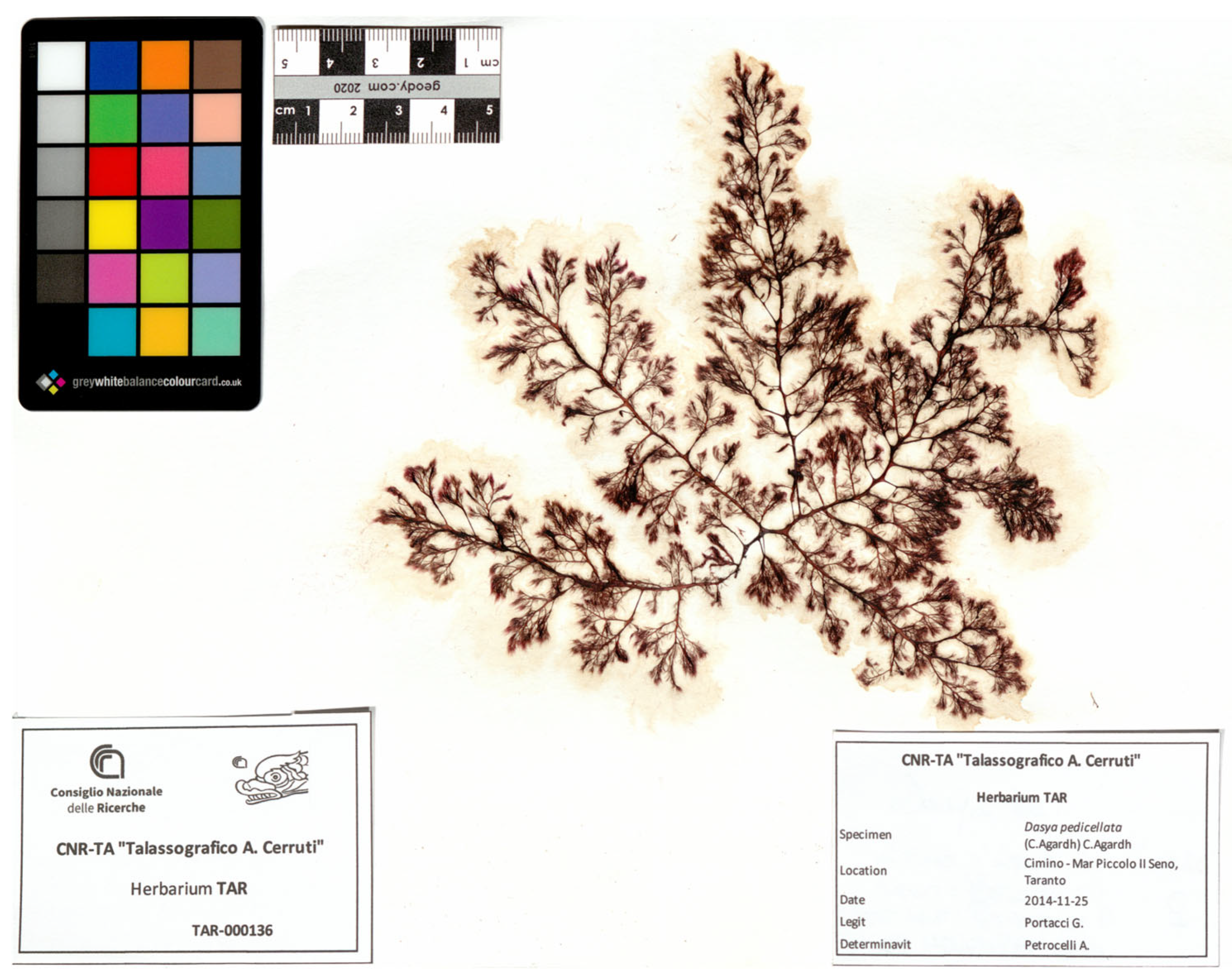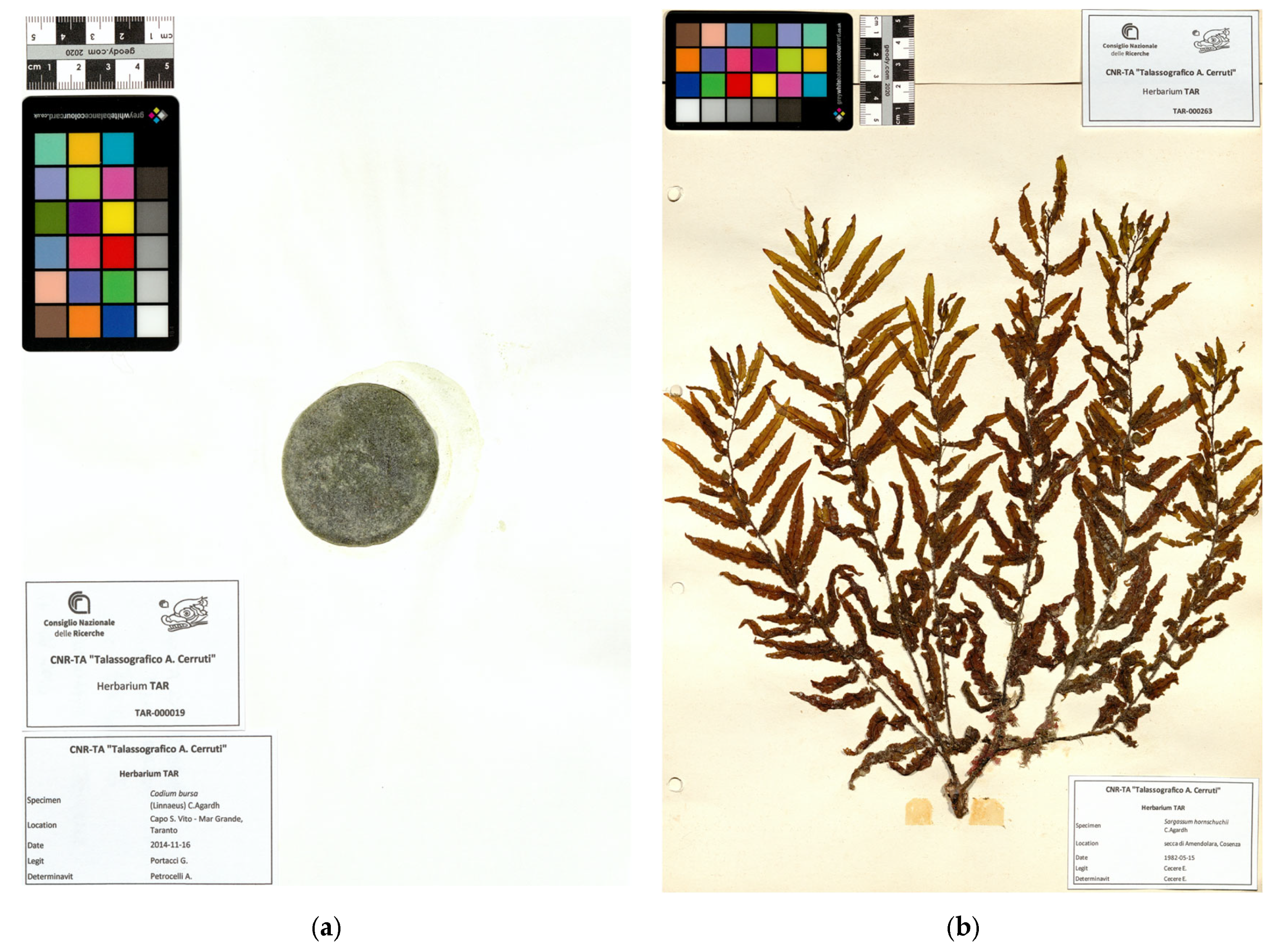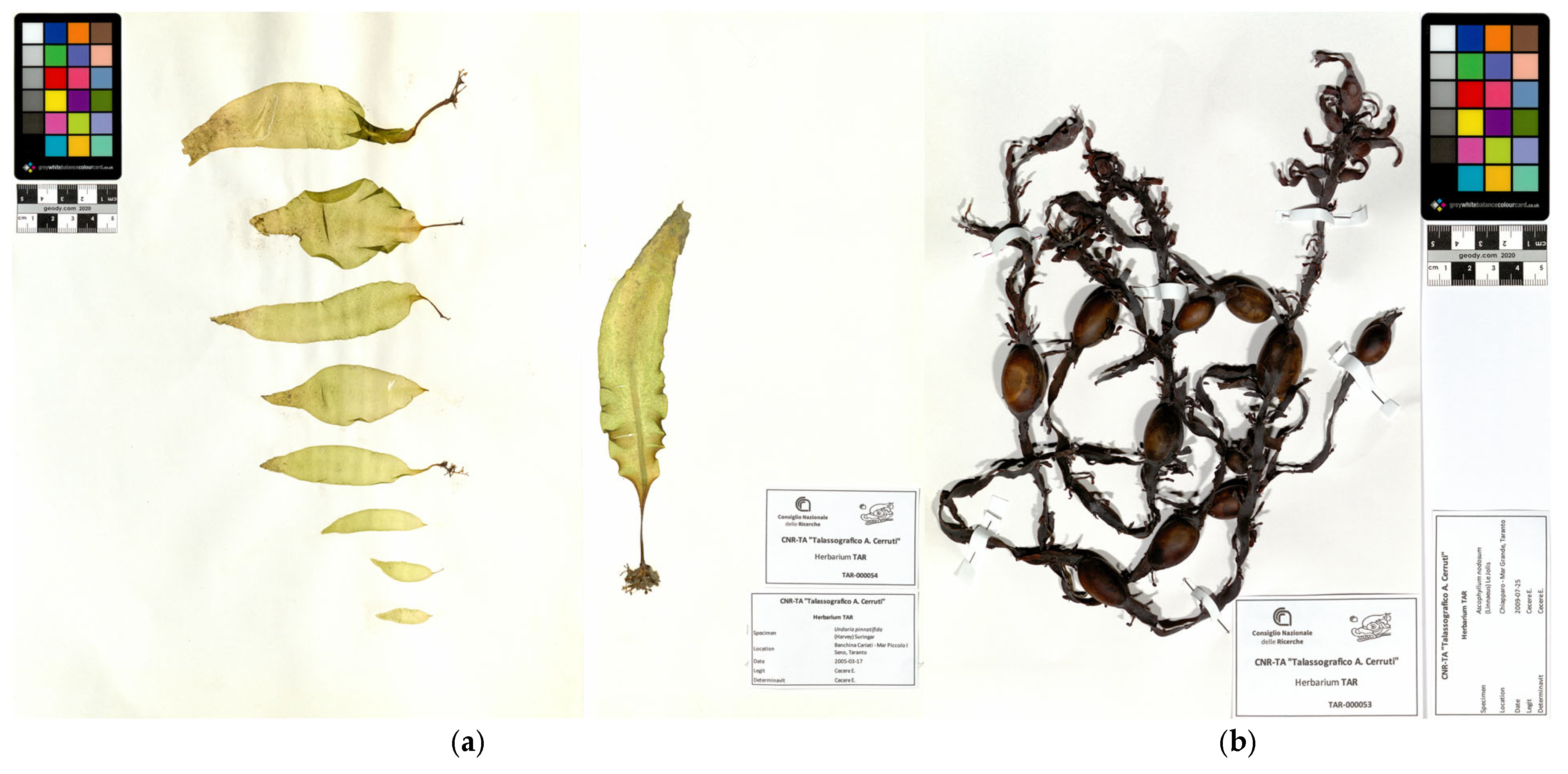Digitization of the Marine Herbarium “TAR” to Increase Biodiversity Knowledge
Abstract
1. Introduction
2. Materials and Methods
3. Results
4. Discussion
5. Conclusions
Supplementary Materials
Author Contributions
Funding
Data Availability Statement
Conflicts of Interest
Abbreviations
| TAR | Herbarium Istituto Sperimentale Talassografico “A. Cerruti”, Taranto |
| CNR | Consiglio Nazionale delle Ricerche |
| NRRP | National Recovery and Resilience Plan |
| ITINERIS | ITalian Integrated Environmental Research Infrastructure System |
| DiSSCo | Distributed System of Scientific Collections |
| FAIR | Findable, Accessible, Interoperable, Reusable |
| GBIF | Global Biodiversity Information Facility |
| NSCs | Natural Science Collections |
| MIDS | Minimum Information about a Digital Specimen |
| GRSciColl | Global Registry of Scientific Collections |
| NIS | Non-Indigenous Species |
References
- Albani Rocchetti, G.; Armstrong, C.G.; Abeli, T.; Orsenigo, S.; Jasper, C.; Joly, S.; Vamosi, J.C. Reversing extinction trends: New uses of (old) herbarium specimens to accelerate conservation action on threatened species. New Phytol. 2021, 230, 433–450. [Google Scholar] [CrossRef]
- Besnard, G.; Gaudeul, M.; Lavergne, S.; Muller, S.; Rouhan, G.; Sukhorukov, A.P.; Vanderpoorten, A.; Jabbour, F. Herbarium-based science in the twenty-first century. Bot. Lett. 2018, 165, 323–327. [Google Scholar] [CrossRef]
- Heberling, J.M. Herbaria as big data sources of plant traits. Int. J. Plant Sci. 2022, 183, 87–118. [Google Scholar] [CrossRef]
- Heberling, J.M.; Prather, L.A.; Tonsor, S.J. The changing uses of herbarium data in an era of global change: An overview using automated content analysis. BioScience 2019, 69, 812–822. [Google Scholar] [CrossRef]
- Davis, C.C. The herbarium of the future. Trends Ecol. Evol. 2023, 38, 412–423. [Google Scholar] [CrossRef]
- Suarez, A.V.; Tsutsui, N.D. The Value of museum collections for research and society. BioScience 2004, 54, 66–746. [Google Scholar] [CrossRef]
- Mares, M.A. Natural science collections: America’s irreplaceable resource. BioScience 2009, 59, 544–545. [Google Scholar] [CrossRef][Green Version]
- Vellend, M.; Brown, C.D.; Kharouba, H.M.; McCune, J.L.; Myers-Smith, I.H. Historical ecology: Using unconventional data sources to test for effects of global environmental change. Am. J. Bot. 2013, 100, 1294–1305. [Google Scholar] [CrossRef]
- Bradley, R.D.; Bradley, L.C.; Garner, H.J.; Baker, R.J. Assessing the value of natural history collections and addressing issues regarding long-term growth and care. BioScience 2014, 64, 1150–1158. [Google Scholar] [CrossRef]
- Jones, C.A.; Daehler, C.C. Herbarium specimens can reveal impacts of climate change on plant phenology; a review of methods and applications. PeerJ 2018, 6, e4576. [Google Scholar] [CrossRef]
- Grandcolas, P. Natural History Collections: An Ancient Concept in a Present and Future Perspective. In Natural History Collections in the Science of the 21st Century: A Sustainable Resource for Open Science; Pellens, R., Ed.; ISTE Ltd: London, UK; Wiley: Hoboken, NJ, USA, 2021; pp. 13–26. [Google Scholar]
- Thiers, B.M. Strengthening partnerships to safeguard the future of herbaria. Diversity 2024, 16, 36. [Google Scholar] [CrossRef]
- Ong, T.J.; Leggett, J.J.; Wilson, H.D.; Hatch, S.L.; Reed, M.D. Interactive information visualization in the digital flora of Texas. In Visual Interfaces to Digital Libraries; Börner, K., Chen, C., Eds.; Lecture Notes in Computer Science; Springer: Berlin, Germany, 2002; Volume 2539, pp. 188–198. [Google Scholar] [CrossRef]
- Harlow, M.; Schmidt, L.; Munoz, P. Digitization of the Grand Teton National Park Herbarium. UW-Natl. Park Serv. Res. Stn. Annu. Rep. 2005, 29, 27–29. [Google Scholar] [CrossRef]
- Flannery, M.C. Plant collections online: Using digital herbaria in biology teaching. Bioscene J. Coll. Biol. Teach. 2013, 39, 3–9. [Google Scholar]
- Seregin, A.P. Making the Russian flora visible: Fast digitisation of the Moscow University Herbarium (MW) in 2015. Taxon 2016, 65, 205–207. [Google Scholar] [CrossRef]
- Seregin, A.P. The largest digital herbarium in Russia is now available online! Taxon 2018, 67, 463–467. [Google Scholar] [CrossRef]
- Popov, D.; Roychoudhury, P.; Hardy, H.; Livermore, L.; Norris, K. The value of digitising natural history collections. Res. Ideas Outcomes 2021, 7, e78844. [Google Scholar] [CrossRef]
- Beaman, R.S.; Cellinese, N. Mass digitization of scientific collections: New opportunities to transform the use of biological specimens and underwrite biodiversity science. ZooKeys 2012, 209, 7. [Google Scholar] [CrossRef] [PubMed]
- Drew, J.A.; Moreau, C.S.; Stiassny, M.L. Digitization of museum collections holds the potential to enhance researcher diversity. Nat. Ecol. Evol. 2017, 1, 1789–1790. [Google Scholar] [CrossRef]
- Nelson, G.; Ellis, S. The history and impact of digitization and digital data mobilization on biodiversity research. Philos. Trans. R. Soc. B 2019, 374, 20170391. [Google Scholar] [CrossRef]
- Niedzielski, P.; Markiewicz, J. Digitalization of herbarium collections as a tool for the commercialization of scientific knowledge. Procedia Comput. Sci. 2023, 225, 2194–2203. [Google Scholar] [CrossRef]
- Hedrick, B.P.; Heberling, J.M.; Meineke, E.K.; Turner, K.G.; Grassa, C.J.; Park, D.S.; Davis, C.C. Digitization and the future of natural history collections. BioScience 2020, 70, 243–251. [Google Scholar] [CrossRef]
- Pandey, R.; Kumar, V. Exploring the impediments to digitization and digital preservation of cultural heritage resources: A selective review. Preserv. Digit. Technol. Cult. 2020, 49, 26–37. [Google Scholar] [CrossRef]
- Corona, L. Digitalization: An overview of the advantages and disadvantages. In Aspects of Digital Libraries—Digitization, Standards, Open Access, Repositories and User’s Skills; Gabbay, L.K., Ed.; IntechOpen: London, UK, 2023. [Google Scholar] [CrossRef]
- Nelson, G.; Paul, D.; Riccardi, G.; Mast, A.R. Five task clusters that enable efficient and effective digitization of biological collections. ZooKeys 2012, 209, 19–45. [Google Scholar] [CrossRef] [PubMed]
- Caspers, M.; Willemse, L.; Raes, N.; Smets, E.; Schalk, P.; Bánki, O.; Gijswijt, G. Quantifying the use of natural history collections. Biodivers. Data J. 2024, 12, e130811. [Google Scholar] [CrossRef] [PubMed]
- Haston, E.; Chapman, C. MIDS: The digitisation standard for Natural Science collections. Biodivers. Inf. Sci. Stand. 2022, 6, e94604. [Google Scholar] [CrossRef]
- Haston, E.; Dillen, M.; Leeflang, S.; Chapman, C. Completing the Completeness Measure: The MIDS Specification. Biodivers. Inf. Sci. Stand. 2024, 8, e137717. [Google Scholar] [CrossRef]
- Wilkinson, M.D.; Dumontier, M.; Aalbersberg, I.J.; Appleton, G.; Axton, M.; Baak, A.; Mons, B. The FAIR guiding principles for scientific data management and stewardship. Sci. Data 2016, 3, 160018. [Google Scholar] [CrossRef]
- Edwards, J.L. Research and societal benefits of the global biodiversity information facility. BioScience 2004, 54, 485–486. [Google Scholar] [CrossRef]
- Cantrill, D.J. The Australasian Virtual Herbarium: Tracking data usage and benefits for biological collections. Appl. Plant Sci. 2018, 6, e1026. [Google Scholar] [CrossRef]
- de la Hidalga, A.N.; Rosin, P.L.; Sun, X.; Bogaerts, A.; De Meeter, N.; De Smedt, S.; Groom, Q. Designing an herbarium digitisation workflow with built-in image quality management. Biodivers. Data J. 2020, 8, e47051. [Google Scholar] [CrossRef]
- Borsch, T.; Stevens, A.D.; Häffner, E.; Güntsch, A.; Berendsohn, W.G.; Appelhans, M.; Zizka, G. A complete digitization of German herbaria is possible, sensible and should be started now. Res. Ideas Outcomes 2020, 6, e50675. [Google Scholar] [CrossRef][Green Version]
- Powell, C.; Krakowiak, A.; Fuller, R.; Rylander, E.; Gillespie, E.; Krosnick, S.; Shaw, J. Estimating herbarium specimen digitization rates: Accounting for human experience. Appl. Plant Sci. 2021, 9, e11415. [Google Scholar] [CrossRef] [PubMed]
- Hardisty, A.; Saarenmaa, H.; Casino, A.; Dillen, M.; Gördderz, K.; Groom, Q.; Hardy, H.; Koureas, D.; Nieva De La Hidalga, A.; Paul, D.L.; et al. Conceptual design blueprint for the DiSSCo digitization infrastructure-DELIVERABLE D8. 1. Res. Ideas Outcomes 2020, 6, e54280. [Google Scholar] [CrossRef]
- Mannino, A.M.; Armeli Minicante, S.; Rodríguez-Prieto, C. Phycological Herbaria as a useful tool to monitor long-term changes of macroalgae diversity: Some case studies from the Mediterranean Sea. Diversity 2020, 12, 309. [Google Scholar] [CrossRef]
- Bishop, A.M.; Wahlert, G.; Seltman, K. Digitization of the UCSB Herbarium Seaweed Collection Provides Vital Data to Better Understand the Changing Marine Environment; UC Santa Barbara: Cheadle Center for Biodiversity and Ecological Restoration. 2025. Available online: https://escholarship.org/uc/item/27z0f9j7 (accessed on 3 September 2025).
- ISO 8601-1: 2019; Date and Time—Representations for Information Interchange—Part 1: Basic Rules. International Organization for Standardization: Geneva, Switzerland, 2019. Available online: https://www.iso.org/standard/70907 (accessed on 20 January 2025).
- ISO 3166-1: 2020; Codes for the Representation of Names of Countries and Their Subdivisions. Part 1: Country Code. International Organization for Standardization: Geneva, Switzerland, 2020. Available online: https://www.iso.org/standard/72482 (accessed on 20 January 2025).
- Petrocelli, A.; Papa, L.; Spada, L.; Cecere, E. The Solieriaceae of the Herbarium TAR; Consiglio Nazionale delle Ricerche—Istituto di Ricerca sulle Acque: Taranto, Italy, 2025. [Google Scholar] [CrossRef]
- Rindi, F.; Bellanti, G.; Annibaldi, A.; Accoroni, S. Reconstructing historical changes in the macroalgal vegetation of a central Mediterranean coastal area based on Herbarium Collections. Diversity 2024, 16, 741. [Google Scholar] [CrossRef]
- Whitley, B.S.; Abermann, J.; Alsos, I.G.; Biersma, E.M.; Gårdman, V.; Høye, T.T.; Jones, L.; Khelidj, N.M.; Li, Z.; Losapio, G.; et al. Harmonising digitised herbarium data to enhance biodiversity knowledge: Major steps towards an updated checklist for the flora of Greenland. Plants People Planet 2025. [Google Scholar] [CrossRef]
- Petrocelli, A.; Cecere, E.; Rubino, F. Successions of phytobenthos species in a Mediterranean transitional water system: The importance of long-term observations. Nat. Conserv. 2019, 34, 217–246. [Google Scholar] [CrossRef]
- Petrocelli, A.; Alabiso, G.; Cecere, E.; Aresta, M. The macroalga Chaetomorpha linum (Cladophorales, Chlorophyta): Preliminary Results on its Capability of Atmospheric Carbon Dioxide Mitigation. In Proceedings of the 5th European Meeting on Environmental Chemistry, Bari, Italy, 15–18 December 2004. [Google Scholar]
- Cecere, E.; Fanelli, G.; Pierri, C.; Portacci, G.; Cavallo, R.A.; Petrocelli, A.; Stabili, L.; Licciano, M.; Trianni, L.; Giangrande, A. Sustainable Use of Coastal Lagoons: Integrated Polyculture Activity in the Mar Piccolo in Taranto (Southern Italy). In Proceedings of the 2nd International Conference on Coastal lagoons, Klaipeda, Lithuania, 4–9 October 2005. [Google Scholar]
- Petrocelli, A.; Wolf, M.A.; Sciuto, K.; Sfriso, A.; Rubino, F.; Ricci, P.; Cecere, E. Long-term data prove useful to keep track of non-indigenous seaweed fate. Front. Environ. Sci. 2023, 11, 1075458. [Google Scholar] [CrossRef]
- Wolf, M.A.; Buosi, A.; Juhmani, A.S.F.; Sfriso, A. Shellfish import and hull fouling as vectors for new red algal introductions in the Venice Lagoon. Estuar. Coast. Shelf Sci. 2018, 215, 30–38. [Google Scholar] [CrossRef]
- Ravaglioli, C.; Benedetti-Cecchi, L.; Bertocci, I.; Maggi, E.; Uyà, M.; Bulleri, F. The role of environmental conditions in regulating long-term dynamics of an invasive seaweed. Biol. Invasions 2022, 24, 1175–1187. [Google Scholar] [CrossRef]
- Cecere, E.; Alabiso, G.; Carlucci, R.; Petrocelli, A.; Verlaque, M. Fate of two invasive or potentially invasive alien seaweeds in a central Mediterranean transitional water system: Failure and success. Bot. Mar. 2016, 59, 451–462. [Google Scholar] [CrossRef]
- Wallace, R.D.; Bargeron, C.T.; Reaser, J.K. Enabling decisions that make a difference: Guidance for improving access to and analysis of invasive species information. Biol. Invasions 2020, 22, 37–45. [Google Scholar] [CrossRef]





| Phylum | Number of Species | Number of Digital Specimens |
|---|---|---|
| Rhodophyta | 71 | 217 |
| Chlorophyta | 29 | 54 |
| Heterokontophyta | 47 | 78 |
| Tracheophyta | 3 | 4 |
| Total | 150 | 353 |
| Rhodophyta | Chlorophyta | Heterokontophyta | Tracheophyta | ||||
|---|---|---|---|---|---|---|---|
| Ahnfeltiaceae | 1 | Bryopsidaceae | 1 | Agaraceae | 2 | Cymodoceae | 1 |
| Bangiaceae | 4 | Caulerpaceae | 2 | Alariaceae | 4 | Posidoniaceae | 1 |
| Bonnemaisoniaceae | 2 | Cladophoraceae | 7 | Chordariaceae | 4 | Ruppiaceae | 1 |
| Callithamniaceae | 4 | Codiaceae | 7 | Cutleriaceae | 1 | ||
| Caulacanthaceae | 1 | Dasycladaceae | 1 | Desmarestiaceae | 2 | ||
| Ceramiaceae | 2 | Halimedaceae | 3 | Dictyotaceae | 6 | ||
| Champiaceae | 1 | Polyphysaceae | 1 | Fucaceae | 5 | ||
| Cystocloniaceae | 2 | Ulvaceae | 7 | Himanthaliaceae | 1 | ||
| Delesseriaceae | 7 | Laminariaceae | 4 | ||||
| Gigartinaceae | 2 | Lessoniaceae | 1 | ||||
| Gracilariaceae | 5 | Sargassaceae | 12 | ||||
| Grateloupiaceae | 3 | Scytosiphonaceae | 4 | ||||
| Halymeniaceae | 2 | Stypocaulaceae | 1 | ||||
| Kallymeniaceae | 1 | ||||||
| Lomentariaceae | 1 | ||||||
| Nemaliaceae | 1 | ||||||
| Peyssonneliaceae | 3 | ||||||
| Phyllophoraceae | 2 | ||||||
| Plocamiaceae | 1 | ||||||
| Pterocladiaceae | 1 | ||||||
| Rhodomelaceae | 18 | ||||||
| Rhodymeniaceae | 1 | ||||||
| Solieriaceae | 3 | ||||||
| Sphaerococcaceae | 1 | ||||||
| Wrangeliaceae | 1 |
| Species | Year of Collection | Phylum |
|---|---|---|
| Agardhiella subulata (C. Agardh) Kraft & M.J. Wynne | 1988, 1989, 2011, 2012, 2013, 2014, 2015, 2016, 2017, 2023 | Rhodophyta |
| Ascophyllum nodosum (Linnaeus) Le Jolis | 2009 | Heterokontophyta |
| Asparagopsis taxiformis (Delile) Trevisan | 2018 | Rhodophyta |
| Caulacanthus okamurae Yamada | 2017, 2018 | Rhodophyta |
| Caulerpa cylindracea Sonder | 1999, 2002, 2007, 2012, 2013, 2014, 2016 | Chlorophyta |
| Codium fragile (Suringar) Hariot | 2009, 2013, 2016 | Chlorophyta |
| Colpomenia peregrina Sauvageau | 2012, 2016, 2018, 2019 | Heterokontophyta |
| Cutleria multifida (Turner) Greville | 2010, 2013 | Heterokontophyta |
| Grateloupia minima P.Crouan & H. Crouan | 2010, 2011, 2015, 2016, 2019, 2020, 2023 | Rhodophyta |
| Grateloupia turuturu Y. Yamada | 2007, 2008, 2009, 2010, 2013, 2015, 2020 | Rhodophyta |
| Hypnea corona Huisman & Petrocelli | 2002, 2003, 2004, 2005, 2014, 2019, 2020 | Rhodophyta |
| Osmundea oederi (Gunnerus) G. Furnari | 2007, 2021, 2023 | Rhodophyta |
| Polysiphonia morrowii Harvey | 2013, 2014, 2015, 2016, 2018, 2019 | Rhodophyta |
| Solieria filiformis (Kützing) P.W. Gabrielson | 1986, 1988, 1989, 1994 | Rhodophyta |
| Undaria pinnatifida (Harvey) Suringar | 1998, 1999, 2005 | Heterokontophyta |
Disclaimer/Publisher’s Note: The statements, opinions and data contained in all publications are solely those of the individual author(s) and contributor(s) and not of MDPI and/or the editor(s). MDPI and/or the editor(s) disclaim responsibility for any injury to people or property resulting from any ideas, methods, instructions or products referred to in the content. |
© 2025 by the authors. Licensee MDPI, Basel, Switzerland. This article is an open access article distributed under the terms and conditions of the Creative Commons Attribution (CC BY) license (https://creativecommons.org/licenses/by/4.0/).
Share and Cite
Papa, L.; Cecere, E.; Petrocelli, A.; Spada, L. Digitization of the Marine Herbarium “TAR” to Increase Biodiversity Knowledge. Diversity 2025, 17, 641. https://doi.org/10.3390/d17090641
Papa L, Cecere E, Petrocelli A, Spada L. Digitization of the Marine Herbarium “TAR” to Increase Biodiversity Knowledge. Diversity. 2025; 17(9):641. https://doi.org/10.3390/d17090641
Chicago/Turabian StylePapa, Loredana, Ester Cecere, Antonella Petrocelli, and Lucia Spada. 2025. "Digitization of the Marine Herbarium “TAR” to Increase Biodiversity Knowledge" Diversity 17, no. 9: 641. https://doi.org/10.3390/d17090641
APA StylePapa, L., Cecere, E., Petrocelli, A., & Spada, L. (2025). Digitization of the Marine Herbarium “TAR” to Increase Biodiversity Knowledge. Diversity, 17(9), 641. https://doi.org/10.3390/d17090641







